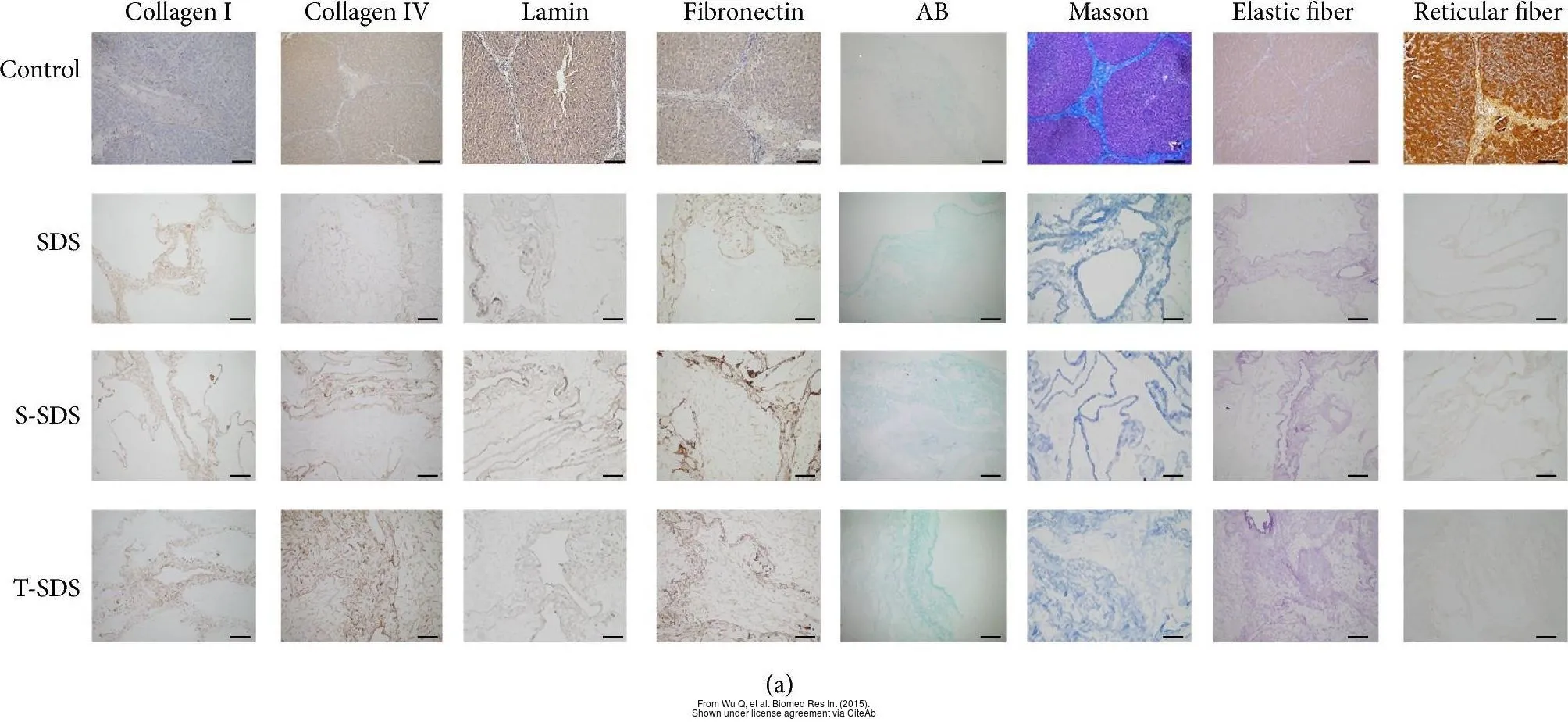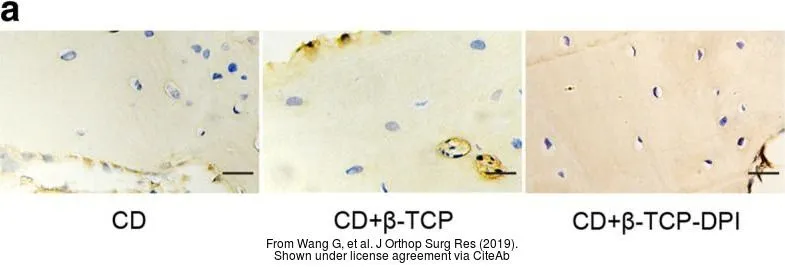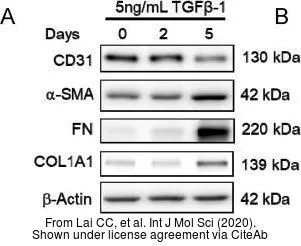![IHC-Fr analysis of pig tongue tissue using GTX26308 Collagen I antibody [COL-1] at 1:4,000. IHC-Fr analysis of pig tongue tissue using GTX26308 Collagen I antibody [COL-1] at 1:4,000.](https://www.genetex.com/upload/website/prouct_img/normal/GTX26308/GTX26308_20170605_IHC-Fr_1_w_23060722_885.webp)
IHC-Fr analysis of pig tongue tissue using GTX26308 Collagen I antibody [COL-1] at 1:4,000.
Collagen I antibody [COL-1]
GTX26308
ApplicationsDot Blot, ImmunoFluorescence, ImmunoPrecipitation, Western Blot, ELISA, ImmunoCytoChemistry, ImmunoHistoChemistry, ImmunoHistoChemistry Frozen, ImmunoHistoChemistry Paraffin
Product group Antibodies
TargetCOL1A1
Overview
- SupplierGeneTex
- Product NameCollagen I antibody [COL-1]
- Delivery Days Customer9
- Application Supplier NoteIHC-Fr: 1:2000. *Optimal dilutions/concentrations should be determined by the researcher.Not tested in other applications.
- ApplicationsDot Blot, ImmunoFluorescence, ImmunoPrecipitation, Western Blot, ELISA, ImmunoCytoChemistry, ImmunoHistoChemistry, ImmunoHistoChemistry Frozen, ImmunoHistoChemistry Paraffin
- CertificationResearch Use Only
- ClonalityMonoclonal
- Clone IDCOL-1
- ConjugateUnconjugated
- Gene ID282187
- Target nameCOL1A1
- Target descriptioncollagen type I alpha 1 chain
- Target synonymscollagen alpha-1(I) chain, alpha-1 type I collagen, collagen, type I, alpha 1
- HostMouse
- IsotypeIgG1
- Protein IDP02453
- Protein NameCollagen alpha-1(I) chain
- Scientific DescriptionCollagens are highly conserved throughout evolution and are characterised by an uninterrupted Glycine X Y triplet repeat that is a necessary part of the triple helical structure. Type I collagen (95 kDa) is found in bone, cornea, skin and tendon. Mutations in the encoding gene are associated with osteogenesis imperfecta, Ehlers Danlos syndrome, and idiopathic osteoporosis. Reciprocal translocations between chromosomes 17 and 22, where this gene and the gene for Platelet-derived growth factor beta are located, are associated with a particular type of skin tumor called dermatofibrosarcoma protuberans, resulting from unregulated expression of the growth factor.
- Storage Instruction-20°C or -80°C,2°C to 8°C
- UNSPSC12352203
References
- Huang L, Zhang S, Wu J, et al. Immunity-and-matrix-regulatory cells enhance cartilage regeneration for meniscus injuries: a phase I dose-escalation trial. Signal Transduct Target Ther. 2023,8(1):417. doi: 10.1038/s41392-023-01670-7Read this paper
- Pei YA, Mikaeiliagah E, Wang B, et al. The matrix microenvironment influences but does not dominate tissue-specific stem cell lineage differentiation. Mater Today Bio. 2023,23:100805. doi: 10.1016/j.mtbio.2023.100805Read this paper
- Gu X, Zhao L, Ye J, et al. 1,25(OH)(2)D(3) ameliorates doxorubicin‑induced cardiomyopathy by inhibiting the NLRP3 inflammasome and oxidative stress. Exp Ther Med. 2023,26(3):413. doi: 10.3892/etm.2023.12112Read this paper
- Zhou Y, Deng G, She H, et al. Polydopamine-coated biomimetic bone scaffolds loaded with exosomes promote osteogenic differentiation of BMSC and bone regeneration. Regen Ther. 2023,23:25-36. doi: 10.1016/j.reth.2023.03.005Read this paper
- Pei YA, Pei M. Hypoxia Modulates Regenerative Potential of Fetal Stem Cells. Appl Sci (Basel). 2022,12(1):pii: 363. doi: 10.3390/app12010363.Read this paper
- Takaya K, Asou T, Kishi K. Aging Fibroblasts Adversely Affect Extracellular Matrix Formation via the Senescent Humoral Factor Ependymin-Related Protein 1. Cells. 2022,11(23). doi: 10.3390/cells11233749Read this paper
- Pei M, Pei YA, Zhou S, et al. Matrix from urine stem cells boosts tissue-specific stem cell mediated functional cartilage reconstruction. Bioact Mater. 2023,23:353-367. doi: 10.1016/j.bioactmat.2022.11.012Read this paper
- Ko S, Jung KH, Yoon YC, et al. A novel DDR1 inhibitor enhances the anticancer activity of gemcitabine in pancreatic cancer. Am J Cancer Res. 2022,12(9):4326-4342.Read this paper
- Cariati I, Bonanni R, Pallone G, et al. Whole Body Vibration Improves Brain and Musculoskeletal Health by Modulating the Expression of Tissue-Specific Markers: FNDC5 as a Key Regulator of Vibration Adaptations. Int J Mol Sci. 2022,23(18). doi: 10.3390/ijms231810388Read this paper
- Xiao W, Chen W, Wang Y, et al. Recombinant DTβ4-inspired porous 3D vascular graft enhanced antithrombogenicity and recruited circulating CD93(+)/CD34(+) cells for endothelialization. Sci Adv. 2022,8(28):eabn1958. doi: 10.1126/sciadv.abn1958Read this paper

![IHC-Fr analysis of human tongue tissue using GTX26308 Collagen I antibody [COL-1] at 1:2,000. IHC-Fr analysis of human tongue tissue using GTX26308 Collagen I antibody [COL-1] at 1:2,000.](https://www.genetex.com/upload/website/prouct_img/normal/GTX26308/GTX26308_20170605_IHC-Fr_w_23060722_261.webp)



![Collagen I antibody [COL-1] detects Collagen I protein at cell membrane by immunohistochemical analysis. Sample: Paraffin-embedded rabbit tongue. Collagen I stained by Collagen I antibody [COL-1] (GTX26308) diluted at 1:200. Antigen Retrieval: Citrate buffer, pH 6.0, 15 min Collagen I antibody [COL-1] detects Collagen I protein at cell membrane by immunohistochemical analysis. Sample: Paraffin-embedded rabbit tongue. Collagen I stained by Collagen I antibody [COL-1] (GTX26308) diluted at 1:200. Antigen Retrieval: Citrate buffer, pH 6.0, 15 min](https://www.genetex.com/upload/website/prouct_img/normal/GTX26308/GTX26308_821905388_20210625_IHC-P_RB_w_23060722_177.webp)
